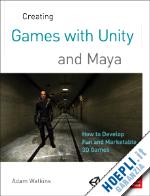Preface Introduction Why this book? Who's it for, and how to use it? Hobbyist strategies Game Developer usage Teacher Student Structure Maya, then Unity Reasoning Book Paradigm Assumptions What we won't be covering Artist Approach vs Programmer/Engineer Approach This book is based upon artist approach Chapter 1 - Game Production Process Game Production Team Members (or roles) All roles can be done by one person Game Production Pipeline in Unity Conceptualization Audience Theme Conceptualization Artwork Art Assets Creation Models Textures Animation Lighting Game Mechanics Scripting Team Game Play Physics Varia What needs to be done when Flexibility of Unity's approach What parts aren't so flexible. How this book mimics the Game Production Process Introduction to The Game we will be producing in the book. Chapter 2 - Asset Creation: Maya Scenography Modeling Scenography Mdeling within the Game Desing Pipeling So Why Maya Tutorials? A Bit of 3D Theory Rendering Video Cards Limitation and Optimization for Games Rules of 3D Game Modeling Polycount Matters Topology is Critical On to the Tools Tutorial 2.1 Game Level Modeling : The Entryway Homework and Challenges Chapter 3 - Asset Creation: Maya Scenography UV Mapping Scenography UV Mapping within the Game Design Pipeline UVs Exploring the UV Texture Editor Tutorial 3.1 Game Level UV Layout: Tools and Techniques Homework and Challenges Chapter 4 - Asset Creation: Maya Sceongraphy Texturing Scenography Texturing within the Game Design Pipleline Textures, Materials & Shaders Nature of Effective Textures Be Square Power of Two Seamless Textures Maya and Unity Tutorials Tutorial 4.1 Seamless Tiled Textures Tutorial 4.2 Non-Tiled Textures and Their Dirt Chapter 5 - Asset Creation: Unity Scenography Importing Introduction to Unity Space Tutorial 5.1 Creating a Unity Project Tutorial 5.2 Exporting from Maya Tutorial 5.3 Importing, Tweaking and Placing Scenography Assets into Unity Chapter 6 - Asset Creation: Unity Scenography Creation Tools Introduction to Non-Imported Assets in Unity Tutorial 6.1 Adding, Manipulating and Understanding Water Tutorial 6.2 Terrain Creation Tutorial 6.3 Tree Building Tutorial 6.4 Particle Creation Chapter 7 - Lighting & Baking What's the big deal with lighting? To light in Maya or Unity? Tutorial 7.1 Lighting Game Level in Unity Baking, textures and AO Tutorial 7.2 Baking in Unity Light maps in Unity Tutorial 7.3 Using Light maps in Unity Chapter 8 - Asset Creation: Maya Character Creations Low Poly character techniques Topology mastery Tutorial 3.1 Game Character Modeling Character UV Tutorial 3.2 Game Character UV Mapping Character Textures Tutorial 3.3 Game Character Texturing Chapter 9 - Asset Creation: Character Rigging and Animation and Import Brief discussion of rigging, skinning, and animation in Maya Tutorial 4.1 Rigging Game Character Tutorial 4.2 Skinning Game Character Game Animation Methodology Tutorial 4.3 Character Idle Unity & Animation Tutorial 4.4 Importing Animated Character and Testing Chapter 10 - Unity Physics Physics engines. PhysX Newtonian physics Unity's use "Frame miss" Elements needed for physics calculations Limitations and overhead Tutorial 7.1 Booby Traps and Physics in Unity Ragdoll Tutorial 7.2 Ragdoll Implementation Chapter 11 - Unity Script: Syntax Power and frustration of scripting Scripting Overview Syntax Discussion MonoBehaviour Commands Functions Variables Inputs Time Components Vectors Coroutines Yields Scripting Cheat Sheets Tutorial 8.1 Constructing Basic Scripts from Scratch Chapter 12 - Unity Script: Triggers What are triggers? Why are they useful? Relationship to Physics What a trigger needs to work How to script a trigger and why Tutorial 9.1 Opening Doors and Tripping Traps Chapter 13 - Unity Script: Inputs, Raycasting and Manipulating Communicating with the game Types of Inputs GUI (for discussion later) Triggers (discussed earlier) Mouse Input Keyboard Input Raycasting When to use which type of input How to call up or "listen for" inputs Tutorial 10.1 Keyboard Driven Mini-Game Tutorial 10.2 Mouse Driven Mini-Game Tutorial 10.3 Raycasting Chapter 14 - Unity Script: Prefabs and Instantiation Power of prefabs Tutorial 11.1 Creating Custom Prefabs Instantiation What are they? What are they for? Why mess with them? Tutorial 11.2 Projectile Instantiation Chapter 15 - Unity Sound Listener/Source Paradigm Attaching sounds Triggering Sounds Listening and tweaking sound qualities Chapter 16 - Unity GUI: OnGUI, GUITextures, GUIText Graphical User Interfaces Theory of design Unity types GUIText GUITextures OnGUI Tutorial 12.1 GUIText and GUITextures for instant feedback Tutorial 12.2 Constructing OnGUI GUI Structure for Game Setup Chapter 17 - Unity GUI and Scripting: Inter-script communication Power of linking scripts Logic engines Health, damage, inventory, death Tutorial 13.1 Creating and Manipulating Health Bar Chapter 18 - Unity Distribution: Builds Getting the game out the door Optimization strategies Profiler Debugger Optimizing game Making Builds PC Mac Web Mobile Devices (overview) iOS Android Tutorial 14.1 Building the Game Appendix A: Setting Projects with Maya Appendix C: Unity Asset Server











